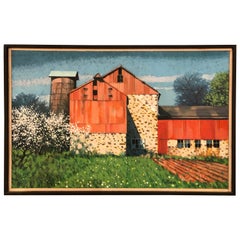John Foster Art
R. John Foster lived all of his life in Newtown, Bucks County, Pennsylvania. He studied at the Philadelphia Museum School of Art under Thornton Oakley and at the Cape Cod School of Art. After serving in World War II as a detachment artist in Iran and Egypt, Foster returned to join the faculty at the Philadelphia Museum School of Art. He served there as director of the Freshman Program (1957–65) and as a professor of drawing and painting. While still a student, he was possibly one of the youngest exhibitors at the Pennsylvania Academy of the Fine Arts (1928) and was invited back in subsequent years, winning the Dana Medal in 1952. His first solo show was in 1934 at the Independent Gallery in New Hope. He frequently exhibited in New Hope at the Phillips Mill Community Association. In Philadelphia, Foster was honored by a solo show at the Art Alliance, a medal at the Watercolor Club, a medal at the Sketch Club in 1952, and a prize at the Woodmere Art Museum in 1974. He also exhibited at the Art Institute of Chicago and the Wilmington Museum of Art. Foster began his career by painting beautiful scenes in and around Newtown in the traditional impressionist manner. He quickly turned to abstract representations. He called his later work Neo-Objective, as it combines representational compositions with cubism. These works have brought him more prizes and recognition throughout his career than his earlier works and are in many important private and museum collections.
1960s North American Modern Vintage John Foster Art
Canvas
1940s American Modern John Foster Art
Oil, Canvas
1940s American Modern John Foster Art
Canvas, Oil
1940s American Modern John Foster Art
Canvas, Oil
1940s American Art Deco Vintage John Foster Art
1940s American Modern John Foster Art
Canvas, Oil
1930s American Modern John Foster Art
Oil, Canvas
1940s American Modern John Foster Art
Canvas, Oil
20th Century American Country John Foster Art
Wood, Paint
1950s American Modern John Foster Art
Oil, Canvas
Late 20th Century Italian Modern John Foster Art
Brass
1930s American Modern John Foster Art
Oil, Canvas
Early 20th Century American Modern John Foster Art
Canvas, Oil
1950s American Modern John Foster Art
Oil, Canvas
1820s English Regency Antique John Foster Art
Mahogany
1970s American Vintage John Foster Art
Canvas





